The Hunting Cutoff Conundrum
Many states let hunters chase turkeys all day. A few others retain a conservative approach. Which is best?
I was tucked into an impromptu blind of fallen branches as I sat against a hardwood.
Dusk had fallen, and darkness threatened its approach. That Oklahoma hunting scenario had allowed me, a New Yorker, the unusual opportunity to pursue my favorite game bird at a time not permitted in my home state.
In fact, 40 states, by my count, allow all-day hunting during all or part of their spring turkey seasons. The remaining nine states that allow spring turkey hunting have taken a more conservative approach.
Missouri is the most recent state to revise its regulations, switching from a 1 p.m. closure to sunset on private land. The 1 p.m. closure remains on public land.
“Our mission is to protect the resource and facilitate opportunity,” said Nick Oakley, wild turkey and ruffed grouse biologist for the Missouri Department of Conservation. “Since 2017, our state has suffered a 15% decline in [hunter] recruitment and retention. Yet in 2020, the year of COVID-19, we saw a spike in participation. That made it clear that if people had the time to hunt, they would do so. So, we wanted to remove a barrier and increase the time to hunt.”
Although those afternoon and evening daylight saving hours allowed hunters increased opportunities, young people in school or day-job workers found the option especially inviting. It might have been their only chance to hunt during weekdays.
Oakley does not fear overharvest on private land because of the regulation change. His department recognized, however, that of the 7% of the state that’s public land, some are small parcels, where a concentration of hunters could create a lot of pressure. Further, during spring, mushroom hunters, birders, hikers and horseback riders on public land might have their experience diminished. Thus, the state retained the 1 p.m. closure on public land.
Since the boom in peak turkey populations, many states have suffered a decline in turkey numbers. They have also experienced a lag in turkey hunter recruitment. The resulting challenge is to stabilize or increase turkey numbers while maximizing hunting opportunities.
Some states have always allowed all-day hunting. In Oklahoma, where I enjoyed an afternoon hunt, all-day spring hunting hours are defined as one-half hour before official sunrise to official sunset. Other states close hunting at 30 minutes before or after sunset. California and Utah have set 5 p.m. as their closing time.
Pennsylvania is one of a few states that have increased hunting hours during part of the season.
“In 2011, Pennsylvania enacted all-day turkey hunting during the second half of the spring season, while a noon closing remained in effect during the first half of the season,” said Mary Jo Casalena, wild turkey biologist for the Pennsylvania Game Commission.
Each year, she said, the commission considered implementing spring hunting opportunities, as directed in the state’s turkey management plan. She and then-NWTF regional biologist Bob Eriksen co-authored a white paper that listed spring turkey hunting options for increasing recreational opportunity to address the biological considerations of each option.
The possibility of turkey hunters disturbing hens on the nest during afternoons is a major consideration for wildlife management agencies. The jointly prepared white paper allowed that all-day hunting is possible toward the end of the season because hunting pressure is largely reduced. Also, hunting methods commonly used during afternoon to dusk usually involve less movement by hunters, affording less hen disturbance. Further, most hens are in the later stages of nest incubation, making them less likely to abandon their nests if disturbance occurs.
Casalena has seen no negative ramifications since Pennsylvania increased its hours in the second half of the season. Oakley opined that hens are very solitary in their nesting habits, and the likelihood of disturbance by hunters is slight.
States understandably do not wish to make changes without scientific support, and a state such as New York has maintained a noon cutoff while managing to keep its turkey population mostly stable.
New York’s turkey management agency, the Department of Environmental Conservation, is updating its 2005 Wild Turkey Management Plan, said Josh Stiller, wildlife biologist for the DEC.
“The impacts of all-day hunting would need to consider the change to harvest, survival and hen-breeding metrics,” he said. “Any changes will be based on sound science and a thorough public input process.”
Doug Little, NWTF’s director of conservation operations in the East, has endorsed such an approach.
“I have 100 percent trust in the research,” he said.
Though New York will be diligent in determining the potential impact of any changes to its regulations, other states can provide data and anecdotal support, although an apples-to-apples comparison cannot be made with so many variables from state to state. Oakley went through diligent study before his state expanded its hours this past spring.
“I do not expect the afternoon and evening harvest to be significant,” he said. “Indiana, for one, has issued statistics on its morning and afternoon harvest, showing that 80 to 90% of that state’s spring harvest has taken place before noon. Other states offer similar statistics.”

Casalena reported that in Pennsylvania, harvest during the expanded hours comprised a small portion — 5 to 6% — of the total season harvest, and mainly occurred from 4 p.m. to 8 p.m. Those later hours are when the bulk of post-noon hunting activity occurs.
Eric Suttles, co-turkey project leader for the Oklahoma Department of Wildlife Conservation, said that heat and stronger winds discourage many hunters from hunting after noon. Nonetheless, the afternoon and early evening hunting option exists.
“We’ve always had these hours in Oklahoma,” he said. “The intention is to allow maximum opportunity.”
Should all states offer all-day spring hunting?
“Every state has to make its own decision on turkey management for what’s best for itself,” Suttles said. “In Oklahoma, all-day hunting works for us.”
